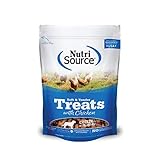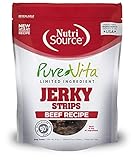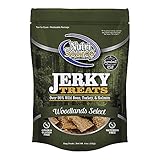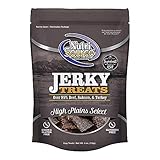If you’ve been scrolling dog-owner forums in the last 48 hours, one topic has lit up the threads faster than a tennis ball at a dog park: the NutriSource dog-treat recall. While recalls are never welcome news, they’re also powerful reminders that the treat pouch clipped to your jeans can either reward good behaviour—or risk your best friend’s wellbeing. Savvy guardians are already asking, “What should I look for in a truly trustworthy brand, not just today, but for the next decade?”
That question is exactly why this guide exists. Below, we’ll move past the headlines and dig into what makes a treat brand worthy of your pup’s wagging tail in 2025 and beyond. You’ll learn the science behind sourcing, the red flags that signal silent recalls, and 10 categories of buying criteria that surpass any single label’s marketing hype. By the time you’re done, you’ll feel confident tossing a reward without second-guessing what’s inside.
Top 10 Nutrisource Dog Treats Recall
Detailed Product Reviews
1. Nutri Source TU80020 14 oz Soft & Tender Chicken Treats for Dogs

Overview: Nutri Source TU80020 14 oz Soft & Tender Chicken Treats for Dogs are single-protein, soft morsels marketed to pet parents who want a gentle, flavorful reward without crunchy crumbs.
What Makes It Stand Out: The ultra-soft texture is ideal for senior dogs, puppies, or dogs with dental issues, and the limited-ingredient chicken formula minimizes allergy risk.
Value for Money: At $17.14 per pound, the treats are premium-priced, but roughly 60-70 bite-size pieces per bag stretches training budgets if broken into smaller bits.
Strengths and Weaknesses: Pros include high palatability, easy chew, and no grain fillers. Cons: bag size is modest for multi-dog households, and the reseal strip occasionally fails, leading to premature drying.
Bottom Line: An excellent high-value training treat for finicky or senior dogs, provided you’re willing to pay gourmet pricing.
2. Variety Pack for Nutrisource-PureVita Hip & Joint and Skin & Coat Dog Treats – Two Salmon Bags, Two Chicken: Packed with Omega 6 & 3 Fatty acids, Glucosamine & Chondroitin (6oz Each, 24 Total)

Overview: This 4-bag salmon and chicken variety bundle supplies hip & joint plus skin & coat formulas, totaling 24 oz of crunchy, bone-shaped biscuits.
What Makes It Stand Out: Each recipe blends real meat with glucosamine, chondroitin, omegas, blueberries, and pomegranates—rare functional extras in a mainstream treat line.
Value for Money: At $1.08 per ounce you’re getting therapeutic joint support that often requires separate supplements, arguably turning treats into dual-purpose spending.
Strengths and Weaknesses: Pros are the dual health benefits, appealing fish-chicken combo, and crunchy texture that helps scrub teeth. Cons: crumbly bones can split in shipping and lighter chewers may find them hard.
Bottom Line: A cost-effective, multifunctional biscuit choice for healthy skin and active joints in a single, tasty rotation.
3. NutriSource Grain-Free Dog Treats, Chicken Biscuits, 14oz

Overview: NutriSource Grain-Free Chicken Biscuits deliver 14 oz of crunchy, heart-shaped rewards built around simple meat-forward recipes and real produce.
What Makes It Stand Out: Grain-free formulation combined with Carniking L-Carnitine supports metabolism without corn or wheat, a boon for sensitive dogs.
Value for Money: At $20.17 per pound packaging feels modest, but ingredient purity and L-Carnitine enrichment position it near vet-quality treat territory.
Strengths and Weaknesses: Pros are clean ingredient panel, crunchy texture for dental hygiene, and inclusive sizing for both large and toy breeds. Cons: bags sometimes air-puffed, leading to more breakage than advertised.
Bottom Line: Recommended for owners prioritizing grain avoidance and metabolic support who don’t mind premium pricing.
4. NutriSource Grain-Free Dog Treats, Made with Liver, 14oz

Overview: These 14 oz liver-flavored grain-free biscuits bring robust protein punch to dogs who crave richer organ-meat flavors.
What Makes It Stand Out: Real liver tops the ingredient list, delivering natural B-vitamins and iron while still fitting grain-free criteria.
Value for Money: Priced at $1.28/oz—near the top of biscuit lanes—the bump reflects concentrated liver, not just marketing hype.
Strengths and Weaknesses: Pros include intense palatability, reliable crunchy texture, and added L-Carnitine. Cons: strong odor may offend sensitive noses, and darker biscuits can stain carpets if dogs carry them around.
Bottom Line: Best suited for high-energy dogs or picky eaters needing extra motivators—keep near the door for quick recall rewards.
5. NutriSource Adult Dry Dog Food, Small Bites, Chicken and Rice, 12LB

Overview: NutriSource’s 12-pound small-bite kibble provides balanced, grain-inclusive nutrition tailored to all life stages with compact kibble size for smaller jaws.
What Makes It Stand Out: The formula folds in prebiotics, probiotics, omega-3/6 balance, and fortified heart-healthy nutrients like taurine and DL-Methionine—all at small-bite scale seldom seen in “large-bag” lines.
Value for Money: At $0.23 per ounce, pricing matches mid-tier grocery brands while delivering premium extras, meaning cost-per-meal competes favorably even with larger bags of economy grain-inclusives.
Strengths and Weaknesses: Pros: small kibble reduces choking risk, rotational feeding encouraged for gut diversity, and wide AAFCO approval. Cons: chicken-centric recipe may disappoint rotational purists seeking novel proteins immediately.
Bottom Line: A reassuring everyday kibble for households ranging from toy breeds to medium seniors seeking gut-friendly, heart-smart nutrition.
6. Nutri Source Limited Ingredient Jerky Dog Treats, Beef, 4 oz

Overview: Nutri Source Limited Ingredient Jerky Dog Treats are small-batch beef strips designed for dogs with sensitive systems. Each 4 oz pouch delivers single-protein nutrition without fillers.
What Makes It Stand Out: The minimalist recipe—beef first, pumpkin second—appeals to allergy-prone pets. Grain-and-gluten-free formulation and the light 4 oz trial size make it an affordable sampler before committing to larger bags.
Value for Money: At $9.99 for 4 oz you’re paying about $2.50/oz. That lands in the mid-premium tier; sensible when you factor in hormone-free beef and U.S. sourcing, but not a bargain bin buy.
Strengths and Weaknesses: Pros: short ingredient list, real protein dominance, fits most elimination diets. Cons: pouch weight (4.8 oz) includes packaging heft, so actual treat yield is slightly under 4 oz, and strips can crumble in transit.
Bottom Line: Best for dogs with food intolerances or first-time tasters. Pick these up if you want a safe, limited-ingredient reward—skip if you need volume training treats.
7. Nutri Source Woodlands Select Jerky Dog Treats

Overview: Woodlands Select Jerky combines 95%+ wild boar, turkey, and salmon into a protein-rich strip that mimics a carnivore’s natural prey mix.
What Makes It Stand Out: Triple-protein variety pack in every strip, sourced in the U.S., with pumpkin for gut health. The 10 oz resealable bag is double most competitors’ size, perfect for multi-dog households.
Value for Money: At $1.36/oz ($13.55/10 oz) this jerky undercuts most boutique brands while meeting the same ingredient quality. You pay slightly more up-front, but the cost per treat is lower than 4 oz alternatives.
Strengths and Weaknesses: Pros: gamey flavor dogs obsess over, generous portion, no artificial preservatives. Cons: richer aroma may offend human noses, strips vary in thickness causing uneven chew time.
Bottom Line: A standout choice for active dogs or picky eaters. Stock this 10 oz bag if you want variety plus value; skip if your dog needs single-protein treats.
8. Nutri Source High Plains Select Jerky Dog Treats, 4 oz

Overview: Sold as High Plains Select, this 4 oz jerky offers the same triple-protein blend as Woodlands—wild boar, turkey, salmon—and touts added vitamin C for immune support.
What Makes It Stand Out: Besides the near-identical recipe to Product 7, the company lists a 20″ cubed package dimension that raises packaging-parcel eyebrows but also promises flat, unbroken strips.
Value for Money: $14.42 for 4 oz equals $3.60/oz—roughly 2.6× the per-ounce cost of the 10 oz Woodlands bag yet holding the same ingredients. You’re paying for convenience, not content.
Strengths and Weaknesses: Pros: same high-protein quality, pumpkin fiber for digestion, vitamin C boost. Cons: laughably high price/oz, packaging likely overspecced, possible labeling overlap with Woodlands.
Bottom Line: Skip unless you only need a travel-size sampler; buy the 10 oz Woodlands instead for identical nutrition at half the cost.
9. Tuffy’S Pet Food Nutrisource Weight Management Dog Food 15Lb

Overview: Tuffy’s NutriSource Weight Management is a 15 lb chicken-and-rice kibble engineered for large-breed dogs carrying extra pounds.
What Makes It Stand Out: Formulated with L-carnitine and balanced macros to reduce calories while conserving muscle mass. The 15 lb bag suits big appetites without the 30-lb storage headache.
Value for Money: At $4.26/lb it sits just above grocery-store brands yet far below prescription weight foods. Given functional ingredients (joint support, probiotics) the spend is justified for weight control.
Strengths and Weaknesses: Pros: chicken as first protein, high fiber to curb begging, added glucosamine. Cons: rice as second ingredient may spike blood sugar in highly insulin-sensitive dogs; kibble size favors medium-to-large breeds only.
Bottom Line: Excellent for pudgy labs and shepherd mixes; select smaller-breed lines if you have a dachshund on a diet.
10. Nutri Source TU80021 14 oz Soft & Tender Lamb Treats for Dogs

Overview: Nutri Source Soft & Tender Lamb Treats deliver 14 oz of bite-sized morsels that are gentle on senior teeth yet potent enough for training rewards.
What Makes It Stand Out: The soft texture eliminates tearing issues of jerky, while single-source lamb appeals to dogs allergic to poultry or beef. Small pieces work straight out of the bag for clicker sessions.
Value for Money: $15.49 computes to $17.70/lb—premium territory. However, 100% lamb protein and resealable fresh-pack justify the spend for special-diet dogs.
Strengths and Weaknesses: Pros: supremely soft, strong lamb aroma, no grains/gluten. Cons: treats dry out if seal is left open, calorie-dense payoffs require portion control during extended training.
Bottom Line: Ideal for training a lamb-loving senior with dental issues. Buy if softness and limited ingredients outweigh bulk value; pass if you need volume jackpot rewards.
Why the NutriSource Recall Sent Shockwaves Through the Pack
A voluntary Class II recall might sound mild until you grasp what “potential salmonella contamination” means for young kids, immunocompromised dogs, and multi-pet households. Social media amplified every affected lot code, turning anecdotal stomach upsets into a viral sense of urgency. Recalls erode trust not because every bag is tainted, but because they highlight gaps we assumed were covered: supplier audits, testing cadences, and transparent communication.
Anatomy of a Dog-Treat Recall: What Really Goes Wrong
Pathogen Detection and Lab Tests
Rapid PCR panels can flag microbes in under 24 hours, yet some producers batch-test only quarterly. We’ll decode why “test and hold” protocols are the gold standard and how low-level positives sometimes trigger recalls despite no confirmed illnesses.
Supply Chain Vulnerabilities
From dehydrated bison sourced in the Midwest to sweet potato flakes arriving from Asia, one weak link can cascade. Understand why ingredient complexity raises risk and how vertically-integrated brands attempt to shrink that chain.
Labeling Oopsies vs. Public-Health Hazards
Not every recall is about salmonella. Mis-printed calories, unlisted pork protein in a “lamb only” treat, or accidental poultry meal in a hypoallergenic recipe can send sensitive dogs straight to the ER. Knowing the difference helps you gauge urgency.
Turning a Recall Into a Teachable Moment for Pet Parents
Instead of panic-buying freezer-safe raw bones, use recalls as checkpoints. Update your treat inventory spreadsheet, check lot codes against FDA databases, and rotate any half-empty bags stocked before the announcement. Small habits compound into big safety wins.
Beyond the Buzzwords: Demystifying ‘Human-Grade,’ ‘Single-Ingredient,’ and Other Labels
The term “human-grade” refers to the entire supply chain, not just the kitchen where the biscuit is baked. Single-ingredient does not automatically mean low-risk; a jerky strip can still harbor rancid fat if the drying curve is off. Here we’ll unpack the technical definitions so marketers can’t twist them into feel-good fluff.
The Science of Ingredient Quality Over Quantity
Meat vs. Meal: Protein Nuance 101
There’s nothing per se wrong with rendered meat meals—unless they arrive in generic “animal digest” form. Learn how to read Guaranteed Analysis sections to gauge digestibility and amino acid profiles.
Hidden Fillers That Trigger Sensitivities
“Pea protein isolate” sounds healthy until it makes up 40 % of a soft chew. Discover how excessive pulse proteins can dilute taurine levels and why limited-ingredient treats aren’t automatically immune.
Safety Certifications You Should Demand in 2025
Third-party seals like SQF, GFSI, and NSF carry weight because auditors physically visit plants, swab meat grinders, and review batch records. Spotting those logos on a bag isn’t just marketing—it’s a signal the company budgets for compliance instead of covering missteps later.
Manufacturing Red Flags Every Pet Parent Should Recognize
Look for plants that separate raw and cooked zones with color-coded utensils, install metal detectors after packaging, and display live COA (Certificate of Analysis) links on their website. Lack of transparency often correlates with corners cut.
Storage, Transport, and Shelf-Life Stability
Oxidation is the silent killer of nutritional integrity. Multi-layer foil pouches flushed with nitrogen, desiccant inserts, and best-by dates printed by thermal ink—not stickers—suggest the company treats shelf life as non-negotiable rather than a negotiable marketing claim.
Rotating Proteins and Textures Without Risking Upset Stomachs
Diversity keeps boredom away, but abrupt changes trigger pancreatitis flare-ups. A rotational protocol starting with 10 % new treats, 90 % old, over a week minimizes GI shock. Freeze-dried cubes for training days, air-dried strips for hikes, and baked biscuits for bedtime set a rhythm your dog anticipates.
Spotting Silent Recalls and Voluntary Market Withdrawals
Not every withdrawal hits the FDA press release page. Follow each brand’s Lot Lookup tool, subscribe to their SMS alerts, and set Google Alerts using phrases like “Brand + recall + 2025.” Many companies quietly pull palatability fails or moldy bags from distribution centers, so vigilance pays.
How to Vet a New Brand Before You Click ‘Add to Cart’
Start with the “About Us” page—date of founding, recall history, corporate ownership. Scroll to the footer: does it list a customer-service phone answered by real people or a no-reply email? Check the FDA Freedom of Information site for 483 inspection reports. Transparency gaps are a bigger red flag than a single ingredient you can’t pronounce.
Single-Ingredient Choices vs. Complex Formulas: Making the Right Bet
Single-ingredient suits elimination diets, but texture variety can aid dental health. Complex, fortified chews can mask synthetic vitamin overages. Matching treat complexity to your dog’s life stage and health status is more nuanced than trend-driven opinions on TikTok.
Budget-Friendly Yet Safe: Maximizing Value Without Cutting Corners
Buying 30-pound bulk boxes of jerky off Amazon feels cheap until half oxidizes in your pantry. Instead, look for 1- or 2-pound resealable bags sold in 4-packs with flat shipping. Loyalty programs offering discount codes after vet visit receipts or recycling pouch send-backs often slash retail prices without compromising safety.
Environmental Pawprint: Sustainable Treat Production in 2025
Eco-criteria are multiplying as fast as puppy teeth: upcycled meat from the human supply chain, solar dehydration, and compostable cellulose pouches. Reward brands that publish annual impact statements and life-cycle assessments; your dog’s snacking habits can drive industry shifts.
Microbiome-Safe Treats for Dogs With Allergies
Low-histamine proteins like rabbit plus certified prebiotic fibres can reduce flare-ups. Hydrolyzed treats (where proteins are broken down into peptides) offer an additional safeguard for dogs with severe food intolerances.
Emergency Planning: What to Do If Your Bag Is in a Recalled Lot
- Stop feeding immediately.
- Snap a photo of the lot code and UPC.
- Seal the bag in a zip-top and refrigerate until further notice.
- File a seller or vet report—even if your dog seems fine—for epidemiological tracking.
- Ask your vet for faecal PCR screening if any GI upsets emerge; early detection prevents secondary spread.
Frequently Asked Questions
-
Are freeze-dried treats safer than dehydrated ones?
Both can be safe when produced under HACCP standards; moisture removal method matters less than post-process packaging and shelf-life testing. -
How often should I rotate my dog’s treat proteins?
Every 6–8 weeks is ideal for healthy adults; dogs with IBD may need longer phases or vet-guided protocols. -
Can treats actually replace part of my dog’s daily calories?
Yes—but follow the 10 % rule: calories from treats should not exceed 10 % of total daily intake unless working with a canine nutritionist. -
Do grain-free treats still pose a DCM risk?
Current literature links DCM more to overall diet balance than single treats; choose legume-light formulations if concerned. -
What should I do if the brand’s “Lot Lookup” won’t load?
Call their customer service with the exact UPC and lot; refusal to disclose is itself a red flag. -
Are imported ingredients always risky?
Not if the brand audits overseas facilities to the same standards as domestic plants. Ask for audit certificates. -
My dog is on a prescription diet—can I still use general-market treats?
Check sodium, phosphorus, and protein content with your vet; limited-ingredient or hydrolyzed options are usually safer bets. -
Are CBD treats regulated like food treats?
No—CBD products fall under a grey legal area in many jurisdictions and are excluded from most quality certification bodies. -
How can I tell if a brand is genuinely eco-friendly vs. green-washing?
Look for third-party seals like B-Corp or Climate Neutral, not just earth-toned packaging. -
Is buying from subscription boxes riskier or safer?
It depends on the box’s curation criteria; choose those that publicly audit treat partners and allow one-click lot-code verification.